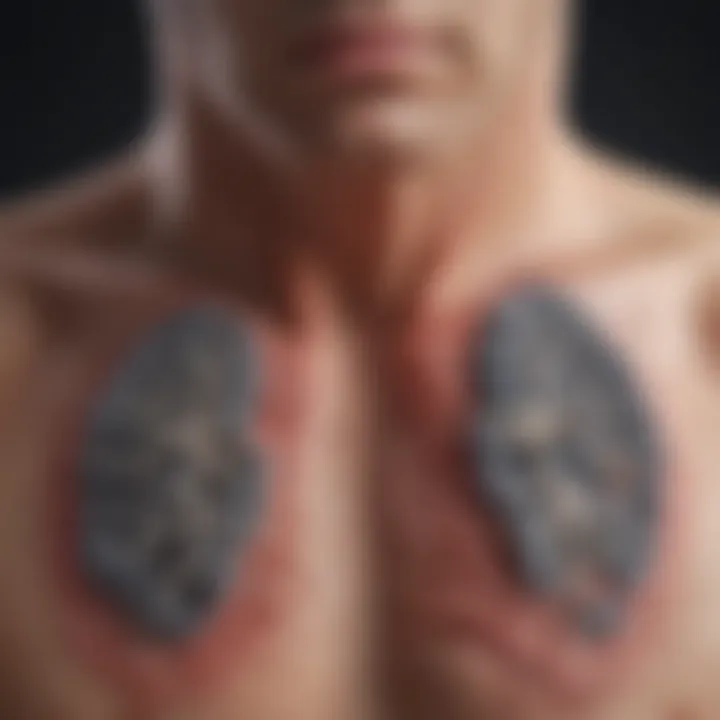Understanding Chronic Obstructive Pulmonary Disease Causes


Intro
Chronic obstructive pulmonary disease (COPD) represents a significant healthcare burden worldwide. At its core, COPD primarily arises from a combination of environmental, behavioral, and genetic factors. Understanding the main causes of this disease can illuminate pathways for prevention and therapeutic strategies.
With this in mind, it is essential to delve into the various contributors that lead to its development. The relentless nature of COPD necessitates proper insight into how it progresses and impacts patients. Importantly, recognizing these causes can facilitate early intervention, which is crucial for improving the quality of life for individuals affected by this condition.
Research Highlights
Overview of Key Findings
Research consistently demonstrates that smoking is the primary risk factor for the development of COPD. Approximately 85% of COPD cases can be linked to tobacco use. In addition to smoking, factors such as long-term exposure to air pollutants, occupational dust, and chemicals can exacerbate lung damage. Genetic variables, particularly deficiencies in alpha-1 antitrypsin, can further predispose individuals to COPD, though this is less common.
Significance of the Research
Understanding these risk factors is vital for developing public health initiatives aimed at reducing the prevalence of COPD. Effective smoking cessation programs, awareness campaigns about air quality, and occupational safety practices can play a pivotal role in mitigating these risks. Additionally, by identifying genetic predispositions, tailored therapeutic strategies can be devised for at-risk populations, potentially reducing the disease burden.
Closure
The need for comprehensive research on the causes of COPD cannot be overstated. Insights gained from this research empower health professionals and researchers to create prevention strategies and targeted interventions that could transform the landscape of COPD management.
Foreword to Chronic Obstructive Pulmonary Disease
Chronic obstructive pulmonary disease (COPD) is a critical area of study in respiratory health. Understanding this disease is essential for several reasons. COPD is not merely a single condition; it comprises various pathologies that obstruct airflow in the lungs, leading to difficulty in breathing. This overview aims to familiarize readers with the complexity surrounding COPD, providing insights into its causes, effects, and management.
Definition and Overview
Chronic obstructive pulmonary disease refers to a group of lung diseases that block airflow, making breathing difficult. The two main types of COPD are chronic bronchitis and emphysema. Chronic bronchitis involves ongoing inflammation of the airway, leading to increased mucus production and coughing. Emphysema is characterized by damage to the air sacs in the lungs, which impairs gas exchange. Together, these conditions result in decreased lung function and significant morbidity.
Globally, COPD is a leading cause of mortality and morbidity, resulting in a substantial burden on healthcare systems. The disease develops gradually, often unnoticed until airflow obstruction becomes severe. Symptoms typically include chronic cough, wheezing, shortness of breath, and increased sputum production. As the disease progresses, it can severely impact daily life and result in frequent hospital visits.
Importance of Understanding Causes
Understanding the underlying causes of COPD is paramount. It provides a foundation for preventive measures, early intervention, and effective management strategies. By identifying key risk factors, healthcare providers can assist individuals at greater risk of developing the disease.
The primary causes of COPD include:
- Cigarette smoking: The most significant risk factor, responsible for the majority of cases.
- Environmental pollutants: Such as chemical fumes and dust, which can exacerbate the condition.
- Genetic factors: Certain genetic predispositions can increase susceptibility to COPD.
- Occupational hazards: Long-term exposure to harmful substances in the workplace can lead to COPD.
- Early-life respiratory infections: These can impact lung development, contributing to later disease.
A comprehensive understanding of these causes empowers stakeholders—patients, healthcare providers, and policymakers—to curb the prevalence of COPD through education, effective policy-making, and health strategies.
"A proactive stance on the prevention and management of COPD can mitigate its effects and improve quality of life for millions of individuals."
Engaging with this topic means committing to not just individual health but also public health and awareness campaigns. The fight against COPD is a multifaceted approach that benefits from increased knowledge and research.
Primary Causes of Chronic Obstructive Pulmonary Disease


Chronic obstructive pulmonary disease (COPD) presents a significant public health challenge worldwide. Understanding its primary causes is essential in identifying the risk factors that lead to its development. Knowledge of these causes not only helps in prevention but also informs targeted interventions and policy decisions. As we delve into the various factors contributing to COPD, we highlight how lifestyle choices, environmental conditions, and biological predispositions intertwine to exacerbate this disease. This understanding lays the foundation for effective public health strategies aimed at reducing prevalence and improving patient outcomes.
Cigarette Smoking as the Leading Cause
Cigarette smoking stands out as the foremost cause of COPD. Long-term exposure to cigarette smoke leads to various pathological changes in the lungs. The combusted tobacco releases thousands of chemicals, many of which are toxic and damaging to lung tissue. This exposure triggers persistent inflammation, destruction of lung parenchyma, and eventual airway remodeling, leading to obstruction. Statistical data shows that around 80% of COPD cases can be attributed to smoking habits.
The importance of proper educational campaigns regarding smoking prevention cannot be overstated. Programs targeting youth, particularly in schools and communities, play a crucial role in informing about the risks associated with smoking. These initiatives can significantly lower the incidence of COPD. Regardless of age, quitting smoking is the best way to stop the disease from progressing.
Environmental Pollution and Its Impact
Environmental pollution is another critical factor contributing to COPD. Air pollutants such as particulate matter, sulfur dioxide, and nitrogen oxides can aggravate existing lung conditions and contribute to new cases. Individuals living in urban areas often encounter higher levels of pollution, which correlates with increased respiratory diseases.
Studies underscore the need for stricter regulations on air quality and pollutants. Reducing emissions from vehicles and industrial facilities can lessen the burden of COPD and lead to improved public health. Communities should invest in clean energy and sustainable practices to protect future generations from the impacts of pollution on respiratory health.
Genetic Predisposition to COPD
Genetic factors also play a role in the development of COPD. Some individuals may inherit a genetic predisposition that makes them more susceptible to lung damage from smoke or environmental factors. Alpha-1 antitrypsin deficiency, for example, is a genetic condition that can increase the risk of developing COPD, particularly emphysema.
Ongoing research in genetics aims to identify how specific gene mutations affect lung function. Understanding these genetic links can enhance prevention and treatment strategies for individuals with a family history of COPD. Genetic screening may become a critical tool for assessing risk in at-risk populations.
Occupational Exposure to Hazards
Certain occupations expose workers to inhalational hazards that can lead to COPD. Those working in construction, mining, or manufacturing may encounter dust, fumes, and chemicals that damage lung tissues over time. OSHA guidelines are in place to protect these workers, but compliance and enforcement can vary significantly.
Employers must prioritize air quality and provide proper protective gear to reduce the likelihood of COPD. Education on recognizing symptoms early can lead to prompt intervention. Encouraging reporting of unsafe work conditions is paramount to safeguarding lung health in these environments.
Respiratory Infections in Early Life
Prior respiratory infections, especially during childhood, can increase vulnerability to COPD later in life. Infections like RSV (respiratory syncytial virus) can lead to lasting damage and reduced lung function.
Public health initiatives seeking to vaccinate children against common respiratory infections can significantly impact future COPD rates. Furthermore, monitoring and treating early childhood respiratory illnesses is critical. By addressing these issues, we can minimize the risk of developing COPD in the adult population.
Understanding the primary causes of COPD is instrumental in shaping prevention and management strategies. A comprehensive approach, taking into account individual, environmental, and occupational factors, is necessary for tackling this pervasive disease.
Pathophysiology of Chronic Obstructive Pulmonary Disease
Understanding the pathophysiology of Chronic Obstructive Pulmonary Disease (COPD) is crucial for several reasons. It provides insights into how the disease develops at the cellular level. This understanding is essential for preventing disease progression and improving treatment strategies. The mechanisms involved in COPD can help healthcare professionals recognize the complexities of the condition. Moreover, a clear grasp of these mechanisms can facilitate better patient education regarding their disease management.
Inflammatory Mechanisms in the Lungs
Inflammation plays a key role in the pathophysiology of COPD. Inhalation of irritants, primarily from cigarettes and pollutants, stimulates the immune response. This leads to the recruitment of inflammatory cells to the lungs. Among these cells are neutrophils, macrophages, and lymphocytes. The activated immune cells release various pro-inflammatory mediators. These mediators can cause damage to lung tissues. Over time, chronic inflammation results in structural changes known as remodeling. Such changes can contribute to narrowed airways and increased mucus production, impairing airflow and leading to the familiar symptoms of COPD.
Airway Remodeling and Obstruction
Airway remodeling is a significant aspect of COPD. This process involves alterations in the structure of the airways due to prolonged inflammation. The smooth muscle cells in the airways may become hypertrophied, and excessive deposition of extracellular matrix can occur. This remodeling results in the thickening of the airway walls. As a result, patients commonly experience airflow obstruction. The elasticity of the lungs is also compromised. This impairment can lead to difficulties in breathing, particularly during exertion. The combination of airway obstruction and airway remodeling tends to result in a progressive decline in lung function.


Emphysema and Its Role in COPD
Emphysema is a type of COPD characterized by damage to the alveoli, the tiny air sacs in the lungs. In emphysema, the walls of these alveoli become destroyed, reducing the surface area available for gas exchange. This leads to reduced oxygen levels in the blood. The loss of elastic recoil contributes to the air trapping phenomenon. Patients with emphysema may present with a barrel chest due to air trapping. Emphysema can be the primary manifestation in many COPD patients, influencing both symptoms and management strategies. Thus, comprehending the role of emphysema in COPD is vital for effective treatment.
It's essential to recognize that the pathophysiology of COPD is multifactorial and involves a complex interplay of genetic, environmental, and lifestyle factors. Understanding these interactions can provide a clearer picture of disease progression and potential therapeutic targets.
In summary, the pathophysiology of COPD encompasses various mechanisms, including inflammation, airway remodeling, and emphysema. These elements are critical in understanding the disease and its management. Recognizing how these mechanisms operate offers essential insights for research and clinical practice.
Diagnosis of Chronic Obstructive Pulmonary Disease
The diagnosis of Chronic Obstructive Pulmonary Disease (COPD) is a crucial aspect of managing this progressive lung disease. Understanding the underlying mechanisms of COPD helps in early detection, which can significantly improve the quality of life for patients. The process of diagnosing COPD involves various components including clinical evaluation and diagnostic tests. This section aims to provide a comprehensive overview of the methods used to diagnose this condition and emphasizes the importance of accurate diagnosis in guiding treatment options.
Clinical Evaluation and Symptoms
Clinical evaluation is the first step in diagnosing COPD. Physicians will typically begin with a thorough assessment of the patient’s medical history and presenting symptoms. Common symptoms might include persistent cough, sputum production, and shortness of breath. Notably, the symptoms often worsen with time, and many patients may have experienced them for years before seeking medical attention.
It is essential to differentiate COPD from other respiratory conditions such as asthma or bronchitis. This distinction is made based on symptom patterns and the patient's smoking history.
Common symptoms of COPD include:
- Difficulty breathing during physical activities. Patients often report feeling winded.
- Wheezing and chest tightness. These symptoms can be indicative of airway narrowing.
- Frequent respiratory infections. Patients may face increased susceptibility to infections.
- Fatigue. Often, patients experience lower energy levels due to breathing difficulties.
In addition to symptoms, healthcare providers may also conduct a physical examination, observing the patient for signs such as prolonged expiratory phase and use of accessory muscles during breathing.
Diagnostic Tests and Imaging
After the clinical evaluation, diagnostic testing is essential to confirm the diagnosis of COPD. Several methods are used to assess lung function and determine the severity of the disease. The following tests are commonly employed:
- Spirometry: This is the cornerstone of COPD diagnosis. It measures how much air a person can breathe out and how quickly. A reduced Forced Expiratory Volume in one second (FEV1) indicates obstructive lung disease.
- Chest X-ray: Imaging helps identify other potential lung issues, and it can rule out conditions mimicking COPD symptoms.
- CT Scan: A computed tomography scan can provide a detailed image of the lungs and may identify emphysema.
- Arterial Blood Gas Test: This test measures oxygen and carbon dioxide levels in the blood, which helps assess lung function and the severity of COPD.
- Alpha-1 Antitrypsin Deficiency Testing: For individuals with a family history of COPD or at a young age of onset, this test checks for a genetic cause of emphysema.
Accurate diagnosis is vital for determining the appropriate management strategies, which can range from lifestyle changes and medications to more advanced therapies. If not diagnosed or treated properly, the outcomes can be debilitating.
"Early diagnosis of COPD can prevent long-term complications and improve patient outcomes."
In summary, diagnosing COPD involves careful clinical evaluation and a variety of diagnostic tests to assess lung function. This process is essential not only in confirming the disease but also in developing effective treatment plans tailored to each patient.
Management and Treatment Options
Managing Chronic Obstructive Pulmonary Disease (COPD) is crucial as it directly influences the quality of life for individuals afflicted with this condition. Effective management can slow disease progression, improve respiratory function, and enhance overall well-being. This section will explore the significance of pharmacological and non-pharmacological treatment approaches, emphasizing their roles in a comprehensive management plan for COPD.
Pharmacological Interventions
Pharmacological interventions are at the core of COPD management. These medications aim to alleviate symptoms, prevent exacerbations, and improve lung function. Commonly utilized drug classes include bronchodilators and corticosteroids.
- Bronchodilators: These medications help open the airways, making it easier to breathe. Short-acting bronchodilators are often used as needed, while long-acting options provide sustained relief for chronic symptoms.
- Corticosteroids: Administered through inhalers, corticosteroids reduce inflammation within the airways. They play a vital role in managing acute exacerbations and help maintain overall lung function.


"Using the right combination of pharmacological therapies can be essential for maintaining stability and preventing hospitalizations in COPD patients."
Adhering to prescribed medication regimens is critical. Patients should be educated about their medications, allowing them to understand the benefits and potential side effects. Regular follow-up with healthcare providers ensures that any adjustments to the treatment plan are based on individual needs and disease status.
Non-Pharmacological Approaches
Complementing pharmacological treatments with non-pharmacological approaches can significantly enhance the management of COPD. These strategies focus on lifestyle modifications and rehabilitative techniques that address physical and emotional well-being.
- Pulmonary Rehabilitation: This structured program aims to strengthen respiratory muscles, improve exercise tolerance, and provide education about the disease. Programs typically include exercise training, nutritional counseling, and support for smoking cessation.
- Smoking Cessation Programs: Given that smoking is the primary cause of COPD, ceasing smoking is the most crucial step. Support may include counseling, medication, and group therapies.
- Nutritional Support: A balanced diet is important for patients with COPD. Nutrition can impact energy levels and overall health. Patients should consult with dietitians to develop meal plans that meet their personal needs.
- Oxygen Therapy: For those with severe COPD, supplemental oxygen can alleviate breathlessness and provide more energy. Monitoring is essential to ensure correct usage and effectiveness.
Prevention Strategies for Chronic Obstructive Pulmonary Disease
Understanding and implementing effective prevention strategies for chronic obstructive pulmonary disease (COPD) is crucial for reducing its prevalence and impact. COPD is often linked to lifestyle choices, particularly smoking and exposure to environmental pollutants. By recognizing these elements, both individuals and communities can take significant steps toward mitigating the risks associated with this disease. The benefits of prevention are manifold, ranging from improving individual quality of life to reducing healthcare costs and enhancing public health overall.
A comprehensive approach to prevention encompasses various strategies. Primarily, it emphasizes behavioral changes and public awareness campaigns that inform the population about the dangers of smoking and pollutant exposure. This type of information can lay the foundation for a culture that prioritizes lung health. In this context, tailored programs that focus on group psychology and shared experiences can also be instrumental in fostering supportive environments for those seeking to quit smoking or address other risk factors.
Moreover, implementing policies to limit exposure to harmful environmental agents can lead to substantial improvements in lung health, benefiting a broader range of individuals. A holistic view, considering both individual and societal factors, can enhance understanding and commitment to preventing COPD.
Smoking Cessation Programs
Smoking is the predominant cause of COPD, accounting for the majority of cases. Hence, smoking cessation becomes a pivotal strategy in combating the disease. Various programs tailored for quitting smoking have been established, targeting different demographics and their specific needs. These programs often include counseling, support groups, and potentially pharmacological aids such as nicotine replacement therapies or prescription medications like varenicline and bupropion.
Research has shown that combination therapy, involving both behavioral support and pharmacotherapy, increases the chances of successful quitting. Furthermore, community-based initiatives can create supportive environments that encourage individuals to quit. This includes offering free resources, providing public education, and enabling access to cessation programs.
"Investing in smoking cessation is a direct investment in improving health and reducing the burden of chronic conditions, including COPD."
Furthermore, recognizing the role of social support is essential. Friends and family can significantly motivate individuals attempting to quit. Thus, involving loved ones in cessation efforts can enhance overall success rates and create a sustainable change in lifestyle choices.
Reducing Exposure to Environmental Pollutants
The other major component in preventing COPD is reducing exposure to environmental pollutants. Many individuals are unaware of the impact that poor air quality and exposure to harmful substances can have on lung health. Airborne substances, including particulate matter, chemicals, and allergens, contribute significantly to the development of COPD.
To address this, community interventions can play a critical role. Governments and organizations can implement policies aimed at reducing emissions from factories, vehicles, and other sources of pollution. Stricter regulations on industrial emissions can significantly decrease environmental toxins and improve air quality.
Public awareness campaigns can also help inform people about the dangers of indoor pollutants such as smoke from wood-burning stoves or air fresheners. Promoting the use of air purifiers in homes, especially in areas with known air quality issues, can also mitigate these risks.
Additionally, educating individuals on the importance of maintaining proper ventilation, avoiding smoking indoors, and using non-toxic cleaning products can promote healthier environments at home and work.
Ultimately, the synergy of personal efforts and community initiatives is vital in tackling COPD prevention comprehensively. By focusing on reducing smoking rates and limiting pollutant exposure, society can make strides toward lowering the burden of this severe disease.
Concluding Thoughts on Chronic Obstructive Pulmonary Disease
Chronic Obstructive Pulmonary Disease is a significant health issue that affects millions of individuals worldwide. It is crucial to recognize the main causes, risk factors, and how to manage this condition effectively. The objective of this article is to provide comprehensive information regarding COPD, allowing for a better understanding of this complex disease. The main points discussed help highlight not just the risk factors but also the underlying mechanisms through which these factors contribute to its development.
In particular, ongoing research plays a vital role. New studies are providing insights that can lead to improved treatment options and better patient outcomes. Understanding these advances is essential for both health care professionals and patients, as it ultimately shapes management strategies and preventive measures. Moreover, bringing light to these findings can offer hope to those affected.
Another key element is public awareness. COPD remains underdiagnosed in many cases. Many individuals may not recognize the early signs or potential risk factors, leading to delayed treatments. Increasing awareness about smoking cessation, environmental factors, and genetic predispositions can help to empower individuals in taking proactive steps towards their health.
"Understanding COPD is a continuous journey, with both research and public awareness playing crucial roles in improving outcomes."
Raising awareness not only aids individuals but also fosters a healthier society. Promoting education initiatives can lead to increased detection rates and, consequently, better health outcomes across populations.







